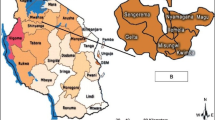Summary
Postpartum visits (PPVs) are still underutilized in rural China, and identification of factors that influence PPV use is important in ensuring the utilization of maternal health services and for wellbeing of women. A cross-section study was undertaken to collect related data from 347 rural women interviewed six weeks or more after delivery, and an ANOVA was performed to find whether there were significant differences in the number of PPVs among different rural areas in China. According to Andersen’s socio-behavioral model of health service use, factors were divided into equitable and inequitable ones. Chi-squared test, univariate and multiple analyses were used to determine the equity of PPV use by identifying factors that were most strongly associated with the use of a PPV. The results showed that 20.2% of the respondents (n=70) did not receive any PPVs, and 62.5% (n=173) of those who had PPVs (n=277) did not receive standard PPVs (referring to at least 3 visits). There was no significant difference among different rural areas in terms of the number of PPVs (F=1.514, P=0.211). Multiple regression analyses revealed that enabling factors such as compensation for delivery expense [OR (95% CI)=2.825 (1.331, 5.995)], village type [OR (95% CI)=1.802 (1.021, 3.182)] and service quality [OR (95% CI)=1.847 (1.074, 3.176)] were strongly associated with PPV use. Both enabling factors such as home visits [OR (95% CI)=1.855 (1.085, 3.174)], service quality [OR (95% CI)=1.993 (1.155, 3.439)] and need factors such as low birth weight [OR (95% CI)=4.424 (1.482, 13.203)] were significantly associated with standard PPV use. Our results suggested that the equitable access to PPVs has been considerably improved in rural areas in China. The associations between inequitable factors and PPV use warrant further exploration, and policies aimed at improving quality and patterns of service supply are needed in order to ensure a full equitable access to maternal health services.
Similar content being viewed by others
References
WHO. Postpartum care of the mother and newborn: a practical guide. Technical Working Group, World Health Organization. Birth, 1999, 26(4):255–258
Högberg U. The World Health Report 2005: “Make every mother and child count”—Including Africans. Scand J Public Healt, 2005, 33(6):409–411
Darmstadt GL, Bhutta ZA, Cousens S, et al. Evidencebased, cost-effective interventions: how many newborn babies can we save? Lancet, 2005, 365(9463):977–988
Quinlivan JA, Box H, Evans SF. Postnatal home visits in teenage mothers: a randomised controlled trial. Lancet, 2003, 361(9361):893–900
MacArthur C, Lewis M, Knox EG. Health after childbirth. BJOG: Int J Gynaecol Obstet, 1991, 98(12):1193–1195
Adam T, Lim SS, Mehta S, et al. Achieving the millennium development goals for health — Cost effectiveness analysis of strategies for maternal and neonatal health in developing countries. Brit Med J, 2005, 331(11):1107–1110
Kerber KJ, de Graft-Johnson JE, Bhutta ZA, et al. Continuum of care for maternal, newborn, and child health: from slogan to service delivery. Lancet, 2007, 370(9595):1358–1369
China’s Ministry Of Health. The management measure of systematic maternal healthcare in rural areas. 1989
China’s Ministry Of Health. Report of the 4th national health service survey in China. Beijing: Xiehe Medical University, 2008
Yuan J, Peng L, Yimin Z. Trend analysis on utilization of health care services for Chinese women of childbearing age during pregnant and puerperal period from 1993 to 2008. Zhong Guo Fu You Bao Jian (Chinese), 2012, 27(2):170–172
The State Council of China: Implementation plan for the recent priorities of the health care system reform (2009–2011). Beijing: The State Council of China, 2009.
UNDP. China Human Development Report. 2009/10: China and a sustainable future: towards a low carbon economy and society. 2010. http://hdr.undp.org/en/reports/national/asiathepacific/china/Chine_2010.pdf
Andersen RM. Revisiting the behavioral model and access to medical care: does it matter? J Health Soc Behav, 1995, 36(1):1–10
China’s Ministry Of Health. Standard Specification of National Essential Public Health Services (2011)
Huang L, Sauve R, Birkett N, et al. Maternal age and risk of stillbirth: a systematic review. Can Med Assoc J, 2008, 178(2):165–172
China’s National Bureau of Statistics. China Statistical Yearbook 2011: China Statistics Press, 2011
Landy CK, Sword W, Ciliska D. Urban women’s socioeconomic status, health service needs and utilization in the four weeks after postpartum hospital discharge: findings of a Canadian cross-sectional survey. Bmc Health Serv Res, 2008, 8(1):203
Sword WA, Krueger PD, Watt MS. Predictors of acceptance of a postpartum public health nurse home visit — Findings from an Ontario survey. Can J Public Health, 2006, 97(3):191–196
Parkhurst JO, Ssengooba F. Assessing access barriers to maternal health care: measuring bypassing to identify health centre needs in rural Uganda. Health Policy Plann, 2009, 24(5):377–384
Raven JH, Chen Q, Tolhurst RJ, et al. Traditional beliefs and practices in the postpartum period in Fujian Province, China: a qualitative study. BMC Pregnancy Childbirth, 2007, 7(1):8
WHO, UNICEF. Home visits for the newborn child: a strategy to improve survival. 2009. http://www.unicef.org/health/files/WHO_FCH_CAH_09.02_eng.pdf
Titaley CR, Dibley MJ, Roberts CL. Factors associated with non-utilisation of postnatal care services in Indonesia. J Epidemiol Commun H, 2009, 63(10):827–831
Marchant T, Willey B, Katz J, et al. Neonatal mortality risk associated with preterm birth in east Africa, adjusted by weight for gestational age: individual participant level meta-analysis. PLoS Med, 2012, 9(8):e1001292
Wilcox AJ. On the importance—and the unimportance—of birthweight. Int J Epidemiol, 2001, 30(6):1233–1241
Author information
Authors and Affiliations
Corresponding author
Additional information
Both authors contributed equally to this work.
This project was supported by the National Natural Science Foundation of China (No. 71273097).
Rights and permissions
About this article
Cite this article
Xiang, Yx., Xiong, Jy., Tian, Mm. et al. Factors influencing the utilization of postpartum visits among rural women in China. J. Huazhong Univ. Sci. Technol. [Med. Sci.] 34, 869–874 (2014). https://doi.org/10.1007/s11596-014-1366-1
Received:
Revised:
Published:
Issue Date:
DOI: https://doi.org/10.1007/s11596-014-1366-1




